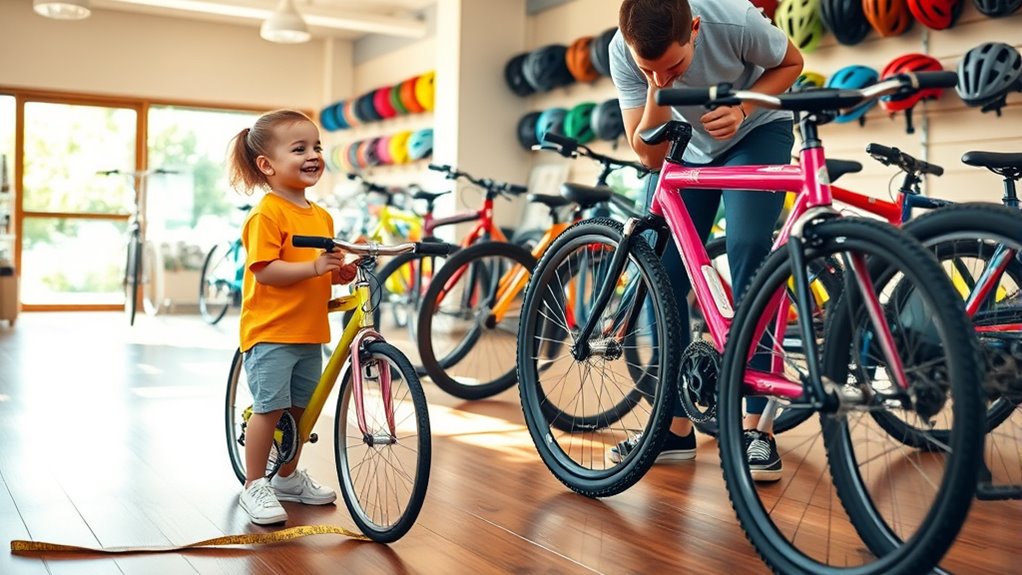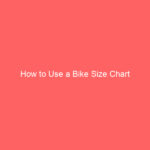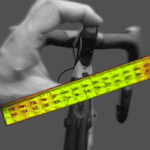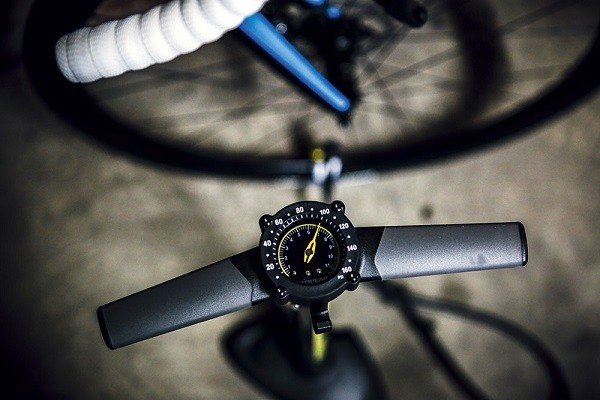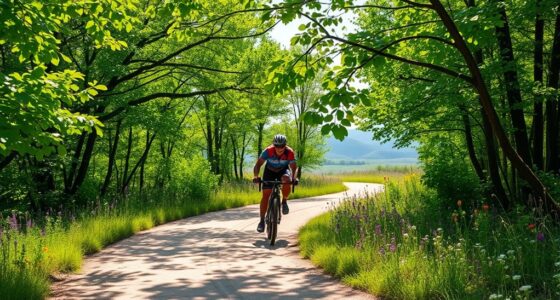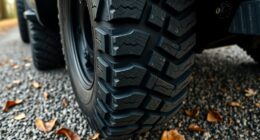Choosing the right bike size is essential for your comfort and performance. Start by measuring your height and inseam to find the right frame and wheel size. Adults use frame size, while kids’ bikes rely on wheel size. Guarantee proper standover height for clearance and leg extension for efficiency. Don’t forget to take into account the type of bike you need, whether it’s a mountain, road, or hybrid bike. There’s even more to learn about finding your perfect fit.
Key Takeaways
- Measure your height and inseam to find the appropriate bike size using specific size charts for different types of bikes.
- Ensure proper standover height clearance: 2-4 inches for mountain bikes and 1-2 inches for road bikes.
- Consider the bike type: mountain, road, hybrid, or gravel, based on your riding preferences and terrain.
- Check for proper leg extension; a slight bend (15-20°) at the bottom of the pedal stroke is ideal.
- Consult a professional bike fitter for personalized adjustments and to enhance your riding comfort and performance.
Understanding Bike Sizing: Adult vs. Kids

When it comes to choosing the right bike size, how do adult and kids’ bikes differ?
Adult bikes primarily rely on frame size for sizing, while kids’ bikes are measured by wheel size, like 12-inch or 16-inch options. Kids typically use these wheel sizes until around age 12, shifting to small adult bikes as they grow.
Although women-specific bike models may provide better-fitting components, there’s no major difference in sizing between men’s and women’s bikes; both can use the same size charts.
For the best fit, consider visiting your local bike shop, as size charts can vary among brands and styles. Additionally, understanding mental wellbeing can enhance your biking experience, ensuring a more enjoyable ride.
Understanding these differences in bike sizing helps guarantee comfort and performance for every rider.
Measuring for the Right Fit
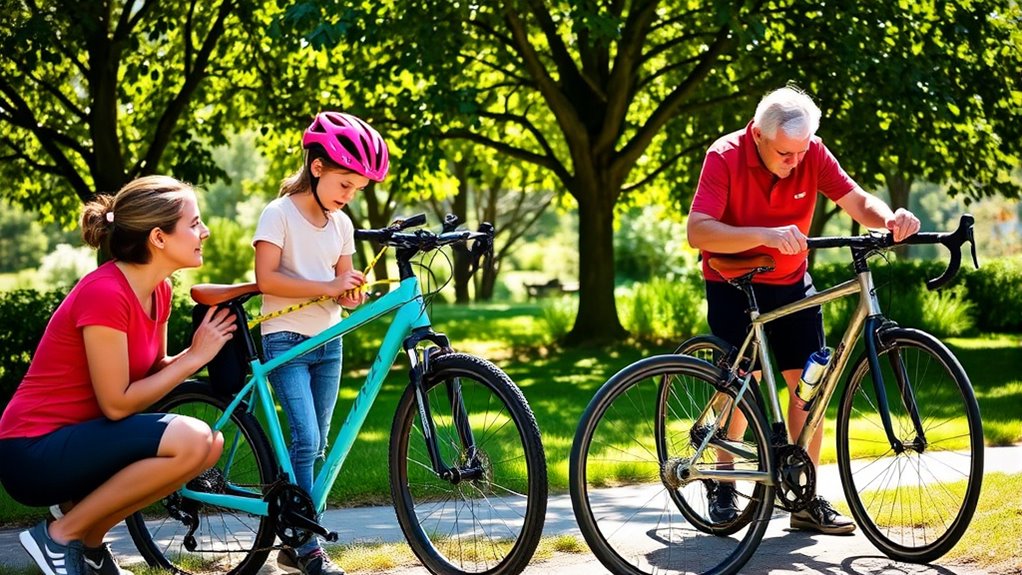
Getting the right bike size starts with accurate measurements of your height and inseam.
First, measure your height by standing against a wall and marking it at head level, then measure from the ground to the mark.
For your inseam, hold a book in your groin against the wall and measure from the book to the floor while wearing shoes.
Use these two measurements to find the appropriate bike size, as different bike types have varying sizing recommendations.
When checking fit, guarantee there’s at least 2-4 inches of clearance for mountain bikes and 1-2 inches for road bikes during the standover height test.
Always consult the size chart specific to the bike type you’re considering for the best fit. Additionally, choosing a bike that promotes balance and coordination can significantly enhance your riding experience and skill development.
Choosing the Right Bike Type
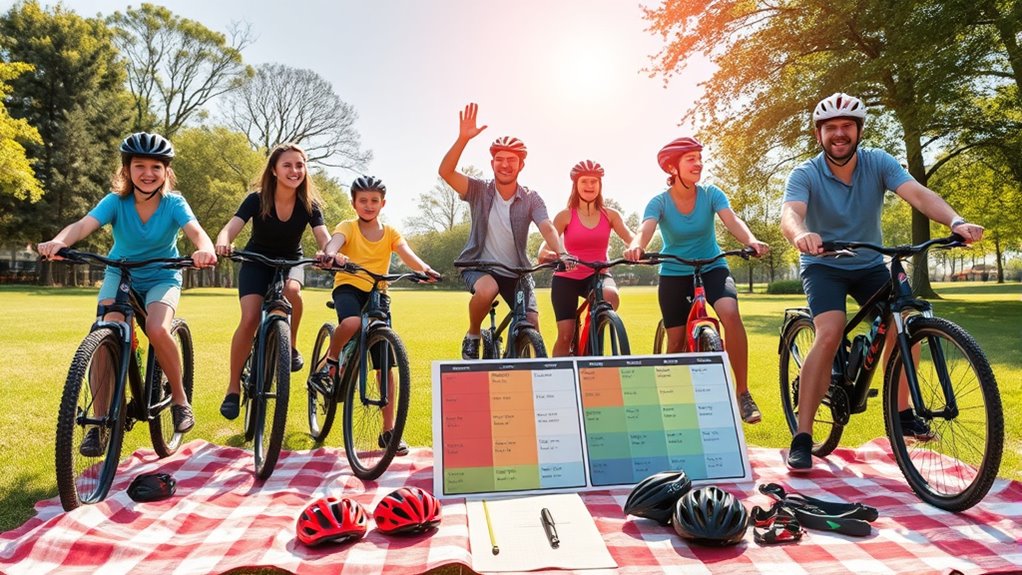
Choosing the right bike type is essential for maximizing your riding experience, as each style caters to different needs and environments. Mountain bikes excel on rugged terrains, while road bikes are optimized for speed on paved surfaces.
If you’re looking for versatility, hybrid bikes combine features from both types, making them perfect for commuters and casual riders. Remember, selecting the right bike type enhances performance and comfort, ensuring a more enjoyable ride.
When bike fitting, consider important measurements like frame size for adults or wheel diameter for kids. Choosing the right size will keep you comfortable on any journey, whether you’re tackling trails or cruising through town. Additionally, gravel bikes are specifically designed for mixed terrain, making them a great option for riders looking to explore both paved and unpaved paths.
Importance of Standover Height and Leg Extension

Finding the right bike type sets the stage for a comfortable ride, but understanding standover height and leg extension is just as important for your safety and performance.
Standover height guarantees you have at least 2-4 inches of clearance for mountain bikes or 1-2 inches for road bikes, preventing injuries during quick dismounts. When testing a bike, straddle the top tube to confirm the frame size fits correctly.
Proper leg extension is crucial for efficient pedaling; your knee should have a slight bend (about 15-20°) at the bottom of the pedal stroke. Adjusting your saddle height to achieve this leg extension enhances comfort and cycling performance, allowing you to pedal effectively without discomfort. Additionally, just like tuning a vehicle for improved performance, ensuring your bike fits well can significantly enhance your riding experience.
Use this fit guide to guarantee the best riding experience.
Tips for Professional Bike Fitting
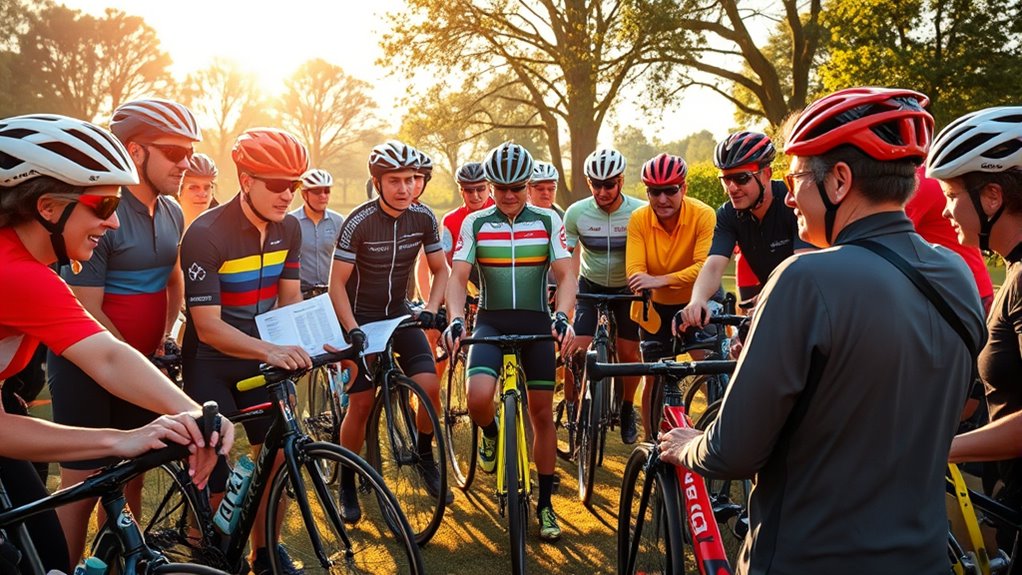
When you invest in a professional bike fitting, you’re setting yourself up for a ride that feels tailored just for you.
Investing in a professional bike fitting ensures a personalized ride experience, perfectly tailored to your unique physique and riding style.
Professional bike fitting services utilize advanced technology to assess your standover height, leg extension, and reach, ensuring proper bike sizing. A proper bike fit enhances comfort and performance by aligning your body correctly with the bike’s geometry.
Expect professional fitters to recommend adjustments like saddle height, saddle fore-aft position, and handlebar height to suit your riding styles. Strong communication skills during the fitting process can help ensure that your specific needs and preferences are fully understood and addressed.
Whether you’re a recreational cyclist or a competitive racer, fitting packages cater to your specific needs. By prioritizing these adjustments, you can optimize your riding experience and prevent discomfort or injuries, making every ride enjoyable and efficient.
Frequently Asked Questions
What Size Bicycle Is Right for My Height?
To find the right bike size for your height, start by measuring yourself.
For road bikes, check your inseam and height against size charts, often listed in centimeters.
If you’re looking at mountain bikes, refer to size categories like S, M, and L.
Make sure you’ve got 1-2 inches of clearance for road bikes and 2-4 inches for mountain bikes when standing over the top tube for a comfortable fit.
What Size Bike for Each Age?
Choosing the right bike size for each age can feel like finding a needle in a haystack!
For toddlers aged 2-4, opt for balance bikes or 12-inch wheels.
As your child grows, a 16-inch bike suits ages 5-7, while 20-inch bikes fit ages 7-10.
By age 9-12, 24-inch bikes are ideal.
Once they hit 12, small adult bikes become the norm.
Always prioritize comfort and confidence over age; every child grows differently!
Is a 26 Inch Bike Good for What Height?
A 26-inch bike‘s great for riders between 5’0″ and 5’6″.
If you’re in this height range, you’ll find it offers a good balance of maneuverability and stability, especially if you’re tackling trails.
Make certain there’s at least 2 inches of clearance when you straddle the bike; this guarantees proper fit and comfort.
If you’re on the taller side of that range, consider test riding to see if it feels right for you.
How Do I Know What Size Bike I Fit?
To find the right bike size for you, start by measuring your height and inseam.
Use these measurements to consult size charts relevant to the bike type you’re considering.
For a comfortable fit, guarantee you have proper standover height—1-2 inches for road bikes and 2-4 inches for mountain bikes.
If you’re between sizes, opt for the larger one.
Don’t hesitate to visit a local bike shop for tailored advice!
Conclusion
So, you’re finally ready to initiate your biking adventure without looking like a circus clown on a unicycle, huh? Remember, choosing the right bike size isn’t just about avoiding embarrassment; it’s vital for comfort and performance. So, measure wisely, consider your standover height, and don’t overlook leg extension—unless you enjoy playing the role of a contortionist. With the right fit, you’ll be pedaling like a pro instead of wobbling like a toddler on training wheels!
